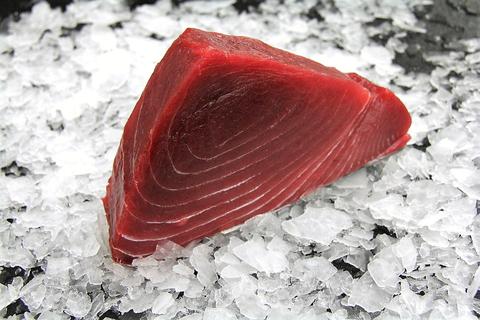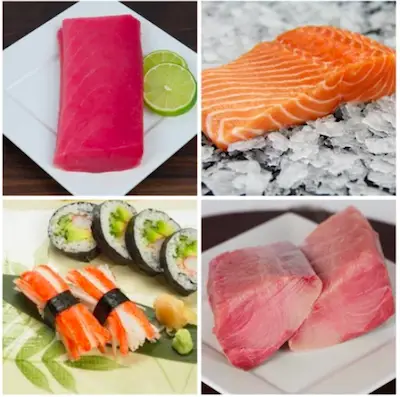We are reader supported. When you purchase through links on our site, we may earn an affiliate commission. Also, as an Amazon affiliate, we earn from qualifying purchases.

In Japan, there is an abundance of sushi bars in every neighborhood so they don’t need to make sushi at home. In western countries, it may be tough to find a sushi restaurant and the good ones can set you back several dollars for a dinner for two. Making your own homemade sushi can be a good option but you will need to take care of a few things.
Do you need sushi-grade fish to make sushi? Yes. Period. If you try making sushi with regular fish from your local fishmonger or supermarket, you stand the risk of contaminating bacterial infection. Raw fish, unless it is sushi grade may contain bacteria and worms that can cause foodborne diseases in humans.
To avoid this, sushi is always made from high-quality fish that is gutted, bled, and flash frozen as soon as they are taken out of the ocean. This is done to kill any form of the parasite in fish so that the raw meat is safe for consumption.
The fish is then packed in iceboxes and transported to different selling points such as your local fishmonger, grocery store, and supermarket. If you have an Asian grocery store near you, I would recommend that you buy fish from there as the staff will have a better idea of sashimi-grade or sushi-grade.
Reasons To Not Buy Regular Fish For Sushi
If you are a sushi beginner, things may appear slightly complicated to you. You may wonder it’s fish after all so why the difference. Well, while almost all fish are frozen as soon as they are out of the water, sushi-grade are treated with extra care during transit as they are meant for raw consumption.
The regular fish on the other is not handled with the intention of using them raw. They are meant to be thoroughly cooked at high heat to kill any parasite or bacteria inside it. As a result, the fish may be thawed and refrozen at certain points during the transit from the boat to the fish market.
The regular fish meat has a higher chance of carrying parasites that start thriving on the flesh as soon as the temperature drops. There are numerous cases of people falling sick because they consumed undercooked fish and accidentally ingested worms that break havoc within the body. Thus, eating the regular fish as a raw delicacy is absolutely out of question.
This explains why you must always buy sushi-grade fish to prepare sushi at home. You must bear in mind that sushi-grade fish is stored at a specific temperature which is only possible in commercial refrigerators that have a higher capacity. So, buy only as much sushi-grade fish as you need for dinner or a party.

The very purpose of flash freezing immediately and maintaining an extremely lower temperature for storage is that the cells within the fish body are solidified, hence the freshness stays intact. Even if you consume a sushi-grade fish that was caught several days before, it will not smell fishy and the flesh will not decay due to the special handling method.
Signs That Tell The Fish Is Sushi-Grade
Don’t feel intimidated when you are out to buy sushi-grade fish on your own. It is actually much easier than you think and soon you will get a hang of what is sushi-grade and what is not by simply looking at the fish. Here are a few important signs you need to consider:
# Look at the eyes
Make eye contact with the fish as the eyes can tell the whole story. As per experienced chefs, the fish eyes should be clear and slightly bulgy with black pupils. If there’s a mist covering the eyes then it indicates that the flesh has decayed. Avoid buying fish with cloudy eyes.
# Sniff the fish
Yes, it may sound obvious for a fish to smell like fish. However, when you are buying sushi-grade, you need to understand the difference between what smells like the ocean or sea air and what smells fishy. If the fish has a strong scent then it’s not safe for raw consumption.
# Poke the flesh
If you are buying fish from a fishmonger, touch the fish to feel the flesh. It should have a shiny skin (not slimy) and firm flesh. Poke the flesh with your finger and it should spring back. If it does not regain its shape then the fish is not sushi-grade.
Even if the fish is packaged (as in a grocery store or supermarket), touch it to ensure that the flesh feels firm and solid. If the flesh feels soft or there are icy particles, then it’s probably not handled properly, hence not sushi-grade.
# Color of the gills
Another good indicator is the gills. If the fish is sushi-grade, the gill will have a bright red color. As the fish decays and gets older, the gills turn dark red. This does not happen in sushi-grade because the specific low temperature does not let the fish age or decay.
Things To Check At The Fishmonger
When you are at the local fish market, ask the fishmonger where the supply of fish came from. If he can’t answer you quickly with confidence then this should be a warning bell.
A good fish market or a trusted fishmonger should be aware of where the fish come from, how they were caught, how they were handled out of the water, and how far they have traveled. Ask these questions to the fish seller to ensure that he knows what is sushi-grade.
If the fishmonger sells you filleted-fish, take a closer look to find any signs of discoloration, dark patches or drying at the edges. I would suggest that you take a look around the fish store or shop too because a dirty area of work or lack of cleanliness indicates carelessness. You would not want to get your sushi-grade fish from there.
Tips To Take Care Of Your Sushi-Grade Fish
If there is an excess amount of unused raw fish, store it the coldest area inside the freezer. Remember to consume within 24 hours as the home fridge is not adequate enough to maintain a very low temperature as per the FDA guidelines. Read about it in my article – what is sushi-grade fish.
When the thawed fish is used for dinner, make sure it does not stay outside in room temperature for more than 4 hours. Be strict about the 4-hour rule for homemade sushi dinner using raw fish to avoid any foodborne disease.
For any reason, if the sushi-grade fish sits outside for more than 4 hours, avoid consuming it raw. You may, however, cook the fish to kill any germs and still use it for your sushi. I have created an article about some of the best-cooked sushi you can make at home.
Top 5 Online Sites To Find Sushi-Grade Fish Online

If you live away from the coastal areas, it may be difficult for you to get sushi-grade fish unless the local fishmonger or supermarket gets a regular supply from a reliable source. Fortunately, we are in the digital where anything possible, even buying sushi-grade fish online. Here are the top 5 online sites that ship high-quality fish suitable for raw consumption.
Catalina Offshore Products
Whether you are a sushi expert or a beginner, you are sure to find something to help you on this site. They have an amazing selection of sushi-grade fish and seafood, so you can go ahead and pick any recipe of your choice. You can also buy sushi-making kits at Catalina if you lack the skills. They have tons of products on offer and the prices are reasonable, so make sure you spend some time on the site.
Honolulu Fish Company
Some of the top sushi chefs from the industry use and recommend the Honolulu Fish Company, the website that sells sashimi-grade fish and hook-caught fillets. Sign up to their emails to get a detail of what’s new sent directly to your inbox. They offer free 2-day shipping on all orders and if you are in a hurry, they can even deliver your order in 24 hours.
Seattle Fish Company
Established in 1918, the Seattle Fish Company has supplied the highest-quality fish to hotels, restaurants, and grocers for over a decade. They have consistently maintained a good reputation for offering a wide variety of sushi-grade fish. Their biggest strength lies in the use of highly advanced packaging materials comprising of dry ice that contribute to maintaining the ideal temperature. Besides selling high-quality seafood, they also offer gourmet foods.
SeafoodS
If you are unsure of buying raw fish from the grocery store, trust the experts who run SeafoodS.com. They take pride in offering a dock-to-door program where the fish straight out of the ocean is frozen and shipped with ice to reach you at the earliest. On their website, you can see an update of what’s available daily on the shore and place your order. There is also no minimum value order and you may purchase a pound or pallets, they value every business.
Kai Gourmet
They promise to deliver the finest but hard-to-find fish caught from the pristine waters in New Zealand to your door within 36 hours. So, if you are in the mood for snapper or barramundi, you know where to order. Besides offering a wide range of fish and seafood, they also bring you some amazing seafood recipes. Join their Friends & Family program to get exciting offers and deals.
Related Questions
Is frozen fish the same as sushi-grade?
Freezing is known to expand the water content within the cells, making the cell membranes disrupt and break. As a result, frozen fish lacks shine and texture. Sushi-grade fish involves special handling with a new freezing technology that chills seafood at -60 degrees Fahrenheit so that the cell membranes are not damaged at all.
Can I use fresh fish for making sushi?
There is nothing called fresh fish for sushi because all fish are frozen as soon as they are out of the water. However, if you live close to the ocean, you can get the freshly frozen fish without having it to travel miles and for days to reach you.
Can I use the fish I caught for making sushi?
As soon as the fish dies, the flesh starts to decay and bacteria start thriving on it. I know that sounds gross but that’s the scenario if the fish is not immediately flash frozen. In the absence of commercial-grade freezers, the best you can do is put fish on a slab of ice and consume immediately.
If you don’t eat the freshly caught and frozen fish immediately, I would strongly advise you to not eat it raw later on. Freshwater fish should never be consumed raw as they contain parasites that can make you sick.
See Also:
How To Make Sushi (7 Quick And Easy Recipe)?
7 Sushi Roll Recipes With Shrimp


